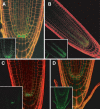Transcriptional profile of the Arabidopsis root quiescent center
- PMID: 15937229
- PMCID: PMC1167541
- DOI: 10.1105/tpc.105.031724
Transcriptional profile of the Arabidopsis root quiescent center
Abstract
The self-renewal characteristics of stem cells render them vital engines of development. To better understand the molecular mechanisms that determine the properties of stem cells, transcript profiling was conducted on quiescent center (QC) cells from the Arabidopsis thaliana root meristem. The AGAMOUS-LIKE 42 (AGL42) gene, which encodes a MADS box transcription factor whose expression is enriched in the QC, was used to mark these cells. RNA was isolated from sorted cells, labeled, and hybridized to Affymetrix microarrays. Comparisons with digital in situ expression profiles of surrounding tissues identified a set of genes enriched in the QC. Promoter regions from a subset of transcription factors identified as enriched in the QC conferred expression in the QC. These studies demonstrated that it is possible to successfully isolate and profile a rare cell type in the plant. Mutations in all enriched transcription factor genes including AGL42 exhibited no detectable root phenotype, raising the possibility of a high degree of functional redundancy in the QC.
Figures






Similar articles
-
The PLETHORA genes mediate patterning of the Arabidopsis root stem cell niche.Cell. 2004 Oct 1;119(1):109-20. doi: 10.1016/j.cell.2004.09.018. Cell. 2004. PMID: 15454085
-
MADS-box gene expression in lateral primordia, meristems and differentiated tissues of Arabidopsis thaliana roots.Planta. 2002 Jan;214(3):365-72. doi: 10.1007/s004250100637. Planta. 2002. PMID: 11855641
-
GIF Transcriptional Coregulators Control Root Meristem Homeostasis.Plant Cell. 2018 Feb;30(2):347-359. doi: 10.1105/tpc.17.00856. Epub 2018 Jan 18. Plant Cell. 2018. PMID: 29352064 Free PMC article.
-
Root development--branching into novel spheres.Curr Opin Plant Biol. 2006 Feb;9(1):66-71. doi: 10.1016/j.pbi.2005.11.004. Epub 2005 Dec 1. Curr Opin Plant Biol. 2006. PMID: 16324881 Review.
-
Insights into multilevel spatial regulation within the root stem cell niche.Curr Opin Genet Dev. 2024 Jun;86:102200. doi: 10.1016/j.gde.2024.102200. Epub 2024 May 4. Curr Opin Genet Dev. 2024. PMID: 38704928 Review.
Cited by
-
Unique cell-type-specific patterns of DNA methylation in the root meristem.Nat Plants. 2016 Apr 29;2(5):16058. doi: 10.1038/nplants.2016.58. Nat Plants. 2016. PMID: 27243651 Free PMC article.
-
Identification of novel loci regulating interspecific variation in root morphology and cellular development in tomato.Plant Physiol. 2013 Jun;162(2):755-68. doi: 10.1104/pp.113.217802. Epub 2013 Apr 10. Plant Physiol. 2013. PMID: 23575417 Free PMC article.
-
A novel bipartite nuclear localization signal guides BPM1 protein to nucleolus suggesting its Cullin3 independent function.PLoS One. 2012;7(12):e51184. doi: 10.1371/journal.pone.0051184. Epub 2012 Dec 10. PLoS One. 2012. PMID: 23251450 Free PMC article.
-
Root Regeneration Triggers an Embryo-like Sequence Guided by Hormonal Interactions.Cell. 2016 Jun 16;165(7):1721-1733. doi: 10.1016/j.cell.2016.04.046. Epub 2016 May 19. Cell. 2016. PMID: 27212234 Free PMC article.
-
Monitoring the regulation of gene expression in a growing organ using a fluid mechanics formalism.BMC Biol. 2010 Mar 4;8:18. doi: 10.1186/1741-7007-8-18. BMC Biol. 2010. PMID: 20202192 Free PMC article.
References
-
- Aida, M., Beis, D., Heidstra, R., Willemsen, V., Blilou, I., Galinha, C., Nussaume, L., Noh, Y.S., Amasino, R., and Scheres, B. (2004). The PLETHORA genes mediate patterning of the Arabidopsis root stem cell niche. Cell 119, 109–120. - PubMed
-
- Alonso, J.M., et al. (2003). Genome-wide insertional mutagenesis of Arabidopsis thaliana. Science 301, 653–657. - PubMed
-
- Aoyama, T., and Chua, N.H. (1997). A glucocorticoid-mediated transcriptional induction system in transgenic plants. Plant J. 11, 605–612. - PubMed
-
- Beissbarth, T., and Speed, T.P. (2004). GOstat: Find statistically overrepresented gene ontologies within a group of genes. Bioinformatics 20, 1464–1465. - PubMed
Publication types
MeSH terms
Substances
Grants and funding
LinkOut - more resources
Full Text Sources
Other Literature Sources
Medical
Molecular Biology Databases

